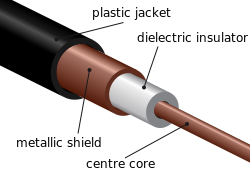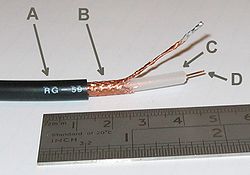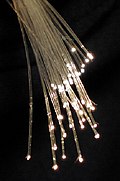Transmission medium
A transmission medium is something (solid, liquid, gas, or plasma) that can transmit energy. For example, the transmission medium for sounds is usually air. But sound can also be transmitted through solids and liquids. A wire can transmit electrons in the form of electricity. There are advantages and disadvantages to every transmission medium.[1] These can be things such as cost, bandwidth (or how much of something can be transmitted), the speed of the transmission and scope.
Telecommunications
Physical mediums: are actually wires or cables used to connect two or more devices. These can be twisted pair, coaxial and fiber optic cables. Twisted pair cables were traditionally used in telephone wire lines and cables. But they are still widely used in networks and other uses. They are called twisted pair cables because they have many small thin insulated wires twisted around each other in a balanced circuit. Twisted pair cables can contain up to 4200 pairs of wires.[2]
Transmission Medium Media
RG-59 flexible coaxial cable composed of: Outer plastic sheathWoven copper shieldInner dielectric insulatorCopper coreA TOSLINK fiber optic audio cable with red light being shone in one end transmits the light to the other end
A wall-mount cabinet containing optical fiber interconnects. The yellow cables are single mode fibers; the orange and aqua cables are multi-mode fibers: 50/125 μm OM2 and 50/125 μm OM3 fibers respectively.







